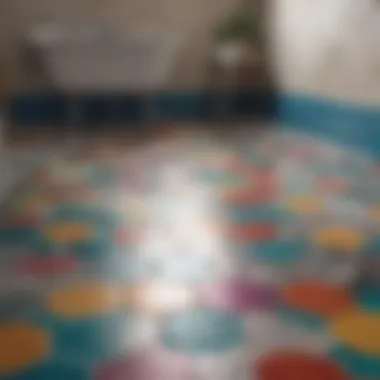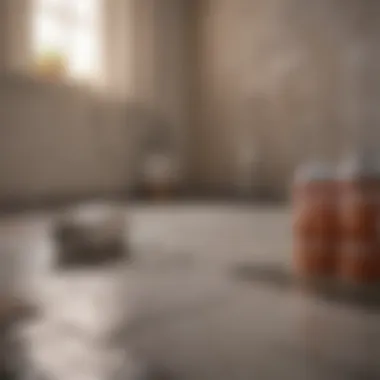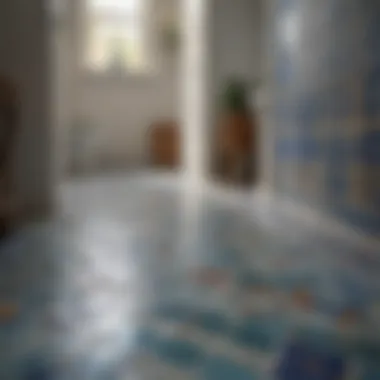Painting Bathroom Floor Tiles: A Comprehensive Guide


Intro
Painting bathroom floor tiles may not be the first thought for some homeowners, yet it is an avenue worth exploring for those seeking an economical yet effective way to revamp their space. As trends in interior design continue to evolve, the preference for personalized and budget-friendly solutions has sparked a growing interest in unconventional methods, such as tile painting.
This practice offers a unique opportunity to completely transform the look of your flooring without the hefty price tag of replacement. It’s a way of breathing new life into tired tiles, allowing for creative expression and modern aesthetics without major renovations. However, as with any home improvement project, there are both perks and pitfalls to consider.
In what follows, this article unpacks various aspects of painting bathroom floor tiles. We will tackle feasibility, necessary preparations, suitable paints, application techniques, and the all-important maintenance. Homeowners and renters will find guidance on how to navigate this potentially complex project, striking a balance between beauty and practicality.
Whether you’re itching for a dramatic change or simply a subtle update, let’s dig into the rich possibilities that await.
Preamble to Painting Bathroom Floor Tiles
The bathroom often acts as a sanctuary where individuals can unwind and refresh. Yet, many err when overlooking the floors, the very foundation of the space. Painting bathroom floor tiles offers not just a frugal way to revamp an aged or dull bathroom, but it also presents an opportunity for personal expression and creativity. By enhancing the tile's appearance, homeowners initiate a ripple effect, transforming the overall ambiance of the room.
Understanding the Concept
Painting tiles isn't merely about applying a fresh coat of color; it involves understanding the unique characteristics of the tiles and the specific requirements of the bathroom environment. Tiles can easily fall victim to moisture and daily wear, so one's approach to painting needs to be tailored specifically to meet these challenges. Not every paint is created equal, and selecting the right type can mean the difference between a successful makeover and a peeling disaster.
The basic idea is straightforward. It begins by choosing a high-quality paint specifically formulated for tiles. However, it doesn’t stop there. Prep work is just as crucial. Ensuring the surface is clean and ready for application sets the stage for success, akin to preparing a canvas before attempting any masterpiece.
Reasons for Painting Tiles
There are many compelling reasons behind the urge to paint bathroom floor tiles:
- Cost-effective Transformation: Replacing tiles can be exorbitant. A solid paint job can breathe life into dated designs without breaking the bank.
- Personal Style: Choosing colors and patterns allows homeowners to express their taste and individuality. You can shift from bland whites to vibrant hues or intricate designs that echo personal decor style.
- Eco-friendly Design: For those keen on sustainability, painting tiles can extend their lifespan, reducing landfill contributions from discarded materials.
- Easier Maintenance: Depending on the paint chosen, finishes can be more resistant to stains and moisture than standard tiles, simplifying cleaning routines.
- Temporary Commitment: Not everyone is ready to commit to a permanent style change. Painted tiles are reversible, providing flexibility for future design choices.
"Transforming a bathroom by painting tiles can lead to surprising synergy in design and personal satisfaction, proving it’s never too late for a change."
As one delves deeper into the intricacies of tile painting, it’s crucial to weigh not just the aesthetics but the practicalities involved. In the following sections, we’ll investigate the feasibility of this project, focusing on which tiles are best suited for painting, the essential preparations needed, and the specific techniques that ensure durability.
Assessing the Suitability of Tile Painting
When considering a home improvement project like painting bathroom floor tiles, it's crucial to assess the suitability of the tiles and the overall environment. This step serves as a critical foundation for ensuring a successful outcome; no one wants to put in effort only for it all to end in disappointment. The characteristics of your tiles and the surrounding conditions significantly influence both the process and result. Thus, taking time to evaluate these factors can save homeowners time and money in the long run.
Types of Tiles Feasible for Painting
Not all tiles are created equal, and knowing which types are prime candidates for painting can steer your project in the right direction. Here’s a breakdown of common tile materials that can be feasibly painted:
- Ceramic Tiles: Often the go-to option. They're relatively smooth and provide a good surface for paint adhesion. Just make sure they’re cleaned well prior.
- Porcelain Tiles: Though a bit tougher to paint than their ceramic cousins, they’re still doable. The right primer and paint can help lock in the finish.
- Vinyl Tiles: The lightweight nature of vinyl makes it easy to apply paint on them, but it’s essential to pick the right kind of paint to prevent peeling.
- Natural Stone Tiles: While more challenging, certain types of natural stone can be painted. It depends on the surface and the specific stone—evaluation is key here.
However, if the tiles are heavily textured or too porous, it might be best to steer clear. Knowing your tiles can make all the difference!


Conditions for Successful Painting
Success in tile painting isn’t just about selecting the right materials. It’s equally about ensuring the right conditions are in place before embarking on your paint journey. Here are vital conditions to consider:
- Cleanliness: The first rule is to have a clean surface. Any dirt, oil, or soap scum can hinder paint adhesion, leading to a flickering finish.
- Moisture Levels: Bathrooms are notorious for high humidity. Ensure the area is dry before starting the project; too much moisture can damage the paint, causing it to bubble or peel away over time.
- Temperature: Aim for a comfortable room temperature. Extreme cold or heat can affect paint curing times. Ideally, the temperature should fall between 50°F and 90°F.
- Ventilation: Make sure there’s good airflow in the space. Not only does this help with paint drying, but it also ensures that any potentially harmful fumes dissipate quickly—no one likes a headache!
"Assessing the suitability of tile painting goes beyond mere aesthetics; it sets the stage for durability and lasting beauty."
By ensuring that your tiles fall into the feasible categories and that the conditions for painting are met, you're well on your way to a successful bathroom transformation. Armed with the right knowledge, you can elevate the space effortlessly and enjoy a refreshed look for years to come.
Essential Preparations Before Painting
Before diving headfirst into the colorful world of painting bathroom floor tiles, it’s prudent to think ahead. Preparations may feel like a chore, but they’re the bedrock for a successful outcome. Proper groundwork ensures that the paint adheres effectively, enhances durability, and ultimately gives your bathroom that polished look. Skipping these steps could lead to peeling paint or an unsightly finish, making it essential to lay the right foundation.
Cleaning the Tiles
Cleaning your tiles is the first step you must take. This part may seem straightforward, but it plays a crucial role. Dust, grime, and soap scum often build up over time and can interfere with paint adhesion. A bad paint job stems from dirty tiles, and all that effort can go to waste if you don’t clean thoroughly.
- Gather Cleaning Supplies: Use a mild detergent and warm water, an abrasive pad, and a mop. For heavy stains, consider a mixture of vinegar and baking soda.
- Scrub the Surface: With your abrasive pad, scrub the tiles down. Pay extra attention to the grout lines where dirt likes to hide.
- Rinse and Dry: After scrubbing, rinse the area with clean water, ensuring no detergent remains. Let the surface dry completely before moving on to the next prep stage.
Regular cleaning not only makes for a better paint job but also sets up a maintainable routine for your tiled surfaces down the line, making this venture worthwhile.
Repairing Damaged Tiles
Repairing any damaged tiles is paramount. This might sound like a nuisance, but cracks and chips act as weak points. Ignoring them will only worsen over time, leading to potential water damage or aesthetic flaws. Ensuring all tiles are structurally intact helps maintain the quality of your work.
- Assess the Damage: Examine each tile closely. Even small imperfections can affect how the paint adheres.
- Patch Up Cracks: Use a suitable filler or epoxy designed for tile repair. Smooth it out for an even finish.
- Replace if Necessary: If a tile is too damaged, replacing it entirely may be the best option. This ensures that your newly painted surface will remain even and beautiful.
Taking the time to repair damaged tiles shows good stewardship, prolonging the life of your surfaces—a point not lost on discerning homeowners.
Priming the Surface
Priming might feel like an optional step, but it’s a game-changer in tile painting. Think of primer as a bridge between the raw tile surface and your beautiful new finish. It helps the paint adhere better, enhances color vibrancy, and provides an extra layer of protection against moisture, which is no small concern in a bathroom environment.
- Choose the Right Primer: Use a primer specifically designed for tile surfaces. An epoxy-based primer works well here.
- Applying the Primer: Using a roller or brush, apply the primer following the manufacturer’s instructions. Ensure even coverage across all tiles.
- Allow to Dry: Give ample time for the primer to cure completely before you start painting. Patience is crucial here.
"Painting tiles without primer is like trying to build a house on sand; without solid ground, it will crumble."
Choosing the Right Paints
The choice of paint can make or break your bathroom floor tile painting project. Not only does the right paint alter the aesthetics of your space, but it can also significantly influence durability and longevity. When selecting paints, it's crucial to consider various elements such as type, finish, and lacquer—all of which play vital roles in the painting results you’ll achieve. An informed choice can lead to a fresh look that stands the test of time, while a poor selection may lead you down a road of frustration and potential reapplication sooner than anticipated.
Types of Paints for Tile Floors


When it comes to selecting the right paint for your tiles, you have a few options available. Here’s a brief overview of the common types that are often considered:
- Epoxy Paint: This type is renowned for its durability and resistance to moisture. Epoxy paint can create a tough surface that withstands heavy foot traffic.
- Latex Paint: Easier to work with, latex paint is also more forgiving in terms of application. However, it may not be as resilient as epoxy paint, making it essential to choose high-quality formulations designed specifically for tile surfaces.
- Acrylic Paint: This water-based paint can offer a wide range of colors and finishes, yet it may require additional coats for effective coverage and durability.
- Specialized Tile Paint: Some brands have developed paints made specifically for tiles. These often come with anti-slip properties which is particularly beneficial for wet areas like bathrooms.
It’s worth reiterating that each type has its particular strengths and weaknesses, making it vital to match their properties with your specific needs.
Factors to Consider When Selecting Paints
Choosing paint isn’t just about picking your favorite color. Various factors should weigh on your decision:
- Durability: Consider how often the bathroom is used and the type of foot traffic the painted floor will experience. If you have a busy household, epoxy might be your best choice.
- Finish: Glossy finishes can be visually striking and provide ease in cleaning, while matte options can offer subtlety but may show wear more quickly.
- Drying Time: If you’re on a tight schedule, check how long the paint will take to dry between coats and fully cure.
- Safety: As bathrooms can be slippery, consider non-slip formulations to prevent accidents, especially if you have little ones scampering around.
- Environmental Conditions: If you live in a humid area, ensure the paint you choose specifically states that it is formulated to resist mold and mildew.
"The key to successful tile painting lies not just in the color, but in the quality and suitability of the paint itself."
By taking the time to evaluate the specifics of each paint type and the factors that influence your choice, you can ensure that your painted bathroom floor tiles will look appealing and perform well over time, enhancing the overall aesthetics and functionality of your space.
Techniques for Painting Floor Tiles
When it comes to sprucing up a bathroom without breaking the bank, painting floor tiles stands as an enticing option. It’s not just an aesthetic upgrade; it opens doors to creativity and expression, while also potentially extending the life of tired tiles. However, the techniques involved in executing this artful undertaking are pivotal. Mastering various painting techniques significantly influences not only the visual outcome but also the durability of the finished product. A smooth, even application can make the difference between a professional look and a patchy job, and that’s why understanding the tools and the proper processes is crucial before diving in.
Tools Required for the Job
A successful tile painting project hinges on having the right tools at your disposal. Here’s a detailed rundown of what you’ll need:
- Floor Paint: You’ll want a high-quality epoxy or specialized tile paint that adheres well to ceramic or porcelain surfaces.
- Primer: Opt for a primer that can withstand moisture since bathrooms are wet zones.
- Paint Rollers and Brushes: Get both a foam roller for larger areas and smaller brushes for edges and detailed work.
- Painting Tray: For easy access to the paint without making a mess.
- Sandpaper: Fine-grit sandpaper is your friend for prepping the tiles and ensuring good adhesion.
- Rags or Sponges: Ideal for wiping surfaces clean and making sure there’s no dust or debris.
- Protective Gear: Gloves, masks, and goggles will safeguard against any splatter or fume inhalation.
This might seem like a basic list, yet each item plays a vital role in achieving a flawless finish. Taking the time to gather these tools helps avoid last-minute runs to the store midproject, which can lead to frustration.
Step-by-Step Painting Process
Once you’ve gathered all your materials, it’s time for the actual painting process. Each step builds upon the previous one, so careful attention is vital. Here’s a straightforward guide to get started:
- Prepare the Area: Clear the floor of all furniture, and cover surrounding areas with drop cloths to protect against spills.
- Clean the Tiles: Thoroughly scrub the tiles using a suitable cleaner, ensuring that no soap scum or grime remains. A clean surface is crucial for adhesion.
- Sand and Repair: Lightly sand the tiles with fine-grit sandpaper to roughen the surface, aiding paint adherence. Repair any damaged tiles with appropriate filler if needed.
- Prime the Surface: Apply primer using a brush or roller, allowing it to dry completely. This step is essential for achieving a professional look and ensuring the paint lasts.
- First Coat of Paint: Using the foam roller, apply the first coat of paint evenly across the tiles. It’s better to use thin layers, which can help avoid drips and achieve even coverage. Let this coat dry thoroughly.
- Second Coat: Repeat the process with a second coat once the first one is dry. Depending on the paint used, a third coat might be necessary for full coverage.
- Sealing the Finish: After the final coat, consider applying a sealant to keep your new floor looking fresh. This adds an extra layer of protection against moisture and wear.
- Drying Period: Allow the tiles to dry for at least 24 to 48 hours before walking on them or returning furniture.
Important Note: Be patient during the process. Rushed jobs rarely yield good results.
Successfully painting bathroom tiles demands attention to detail and patience. Remember, it's not merely about slapping on some paint; it’s a transformative process that can uplift the feel of your entire space. Paying heed to techniques can result in a bathroom floor that looks refined and is robust enough to stand the test of time.
Evaluating the Pros and Cons
In the quest for enhancing bathroom aesthetics while maintaining durability, evaluating the pros and cons of painting floor tiles stands as a critical junction for homeowners and design enthusiasts alike. This analysis helps anyone considering this project weigh the benefits against potential drawbacks. Understanding these facets is key to making an informed decision that aligns with personal style and practical needs.
Benefits of Painting Bathroom Floor Tiles


Painting bathroom floor tiles can offer a host of benefits that go beyond mere aesthetics. Here are some compelling reasons why homeowners might consider this option:
- Cost-Effective Renovation: It's often less expensive to paint tiles than to replace them entirely. New tile installation can break the bank, especially in larger bathrooms. Painting can give an updated look without the hefty price tag.
- Creative Freedom: The artistic possibilities are seemingly endless. Homeowners can choose colors that match their style or even create intricate patterns. This allows for a bathroom that not just meets functional needs but also reflects personal taste.
- Quick Transformation: Unlike a full renovation that can take weeks, painting tiles can be done in a matter of days. This quick turnaround is attractive to those who want to enhance their space without a prolonged disruption.
- Enhanced Durability: When done correctly with the right products, painted tiles can withstand the wear and tear of daily use. Some modern paints are water-resistant and can hold up against humidity, making them suitable for shower areas too.
"Creativity is intelligence having fun." This saying rings true with tile painting, as it allows the merging of functionality and artistic expression.
Despite these benefits, potential downsides must be considered.
Potential Drawbacks and Challenges
While painting tiles can rejuvenate a bathroom's appearance, there are notable challenges worth mentioning:
- Preparation is Key: The preparation process can be tedious. Cleanliness and fixing any imperfections are crucial to ensure a proper bond between the paint and tile. Skipping these steps can lead to peeling and flaking in the future.
- Longevity Concerns: Although modern paints are designed to be robust, they may not be as durable as new tiles. Over time, painted surfaces can wear down, necessitating touch-ups or even complete repainting, which could be an inconvenience.
- Limited Color Choices: While there are numerous colors available, some might find that certain shades do not hold up as intended under the bathroom's lighting. This could lead to dissatisfaction if expectations aren't met.
- Not Always a DIY Job: For those inexperienced in home improvement projects, painting tiles can be tricky. The learning curve may lead to less-than-desirable results if mistakes are made during the painting process.
In summary, while painting bathroom tiles can breathe new life into a space and offers a range of benefits, it's essential to consider the associated challenges. Doing so ensures a positive outcome, transforming your bathroom into a truly personalized haven.
Long-Term Maintenance of Painted Tiles
Maintaining painted bathroom floor tiles is crucial for ensuring they retain their charm and durability over time. After all the hard work that goes into painting tiles, you want to make sure that the results last and continue to enhance your space. In this section, we’ll explore essential aspects of long-term maintenance, focusing on proper cleaning methods, avoiding wear and tear, and recognizing when it’s time for a refresh. A well-maintained surface not only looks appealing but also increases the lifespan of your tiles, proving the effort put into painting was worthwhile.
Cleaning and Caring for Painted Surfaces
Keeping those painted tiles in tip-top shape requires a gentle approach. Heavy-duty cleaners can ruin the paint, so it's best to stick with mild solutions. Here are some tips for cleaning and caring for your painted tiles:
- Use Mild Detergents: Mix a few drops of gentle dish soap with warm water. This combination works wonders without harming the paint.
- Soft Cloths or Mops: Always grab a soft cloth or mop. Avoid scrub brushes or rough sponges which might scratch the surface.
- Regular Maintenance: Wipe down the tiles frequently. Dust and dirt can accumulate, so a simple swish with a damp cloth can keep the surfaces looking fresh.
- Spot Cleaning: If you happen to spill something, clean it right away. Leftover stains can become a hassle if they settle, so prompt attention is key.
By sticking to these methods, your painted tiles can look like new for quite some time.
Signs that Repainting May be Required
Even the most diligent care can’t prevent wear entirely. Over time, it may become evident that a fresh coat of paint is necessary. Here are symptoms to watch out for:
- Chipping or Peeling: If you notice any flaking, it’s a clear sign the paint is losing its grip.
- Fading Colors: Exposure to sunlight and regular foot traffic can dull the paint. If you notice significant fading, consider repainting to restore vibrancy.
- Stains that Won't Budge: If stains have settled in and your cleaning efforts are futile, it may be time to re-evaluate the paint job. Sometimes, wear and tear get the best of us.
- Crack Formation: Small fissures may appear over time. While not all cracks necessitate immediate action, widespread cracking often indicates a need for a fresh start.
Regular check-ups on your painted tiles can help you spot these signs early on. A little observation goes a long way in maintaining the aesthetic appeal and functionality of your bathroom floors.
End: Is Painting Your Bathroom Floor Tiles Worth It?
Painting bathroom floor tiles can be a game changer, and when you consider the implications of this choice, it becomes clear why many homeowners are buzzing about it. Not only does painting allow for personalization of outdated spaces, but it can also save a significant budget when compared to traditional tile replacement. However, navigating this process warrants careful thought.
It’s important to weigh the benefits alongside considerations such as durability and maintenance. On one hand, a fresh, painted floor can breathe new life into your bathroom, creating a more inviting and aesthetically appealing environment. Many people have successfully transformed dull, worn sets of tiles into vibrant, chic patterns that mirror current design trends. Moreover, it lets you explore tiles in colors and designs that may seem impractical or overly costly with traditional installation.
On the other hand, painted tiles are not impervious to wear and tear. Over time, the finish can wear away, especially in high-traffic areas, requiring touch-ups or even a complete repainting sooner than one might hope. Factors such as humidity, frequent foot traffic, and exposure to cleaning agents can influence the longevity of your painted surface. As such, it's wise to consider whether or not this will align with your particular lifestyle and how often the bathroom is used.
"Not all that glitters is gold. Research and understand what suits your needs best."
Speaking practically, these painted tiles demand a wee bit more TLC than their unpainted counterparts. Depending on paint quality and preparation, maintenance can vary. Hence, homeowners looking for a quick fix might find themselves in for a surprise when regular upkeep becomes a bit more demanding.
So, is it worth it? The answer often boils down to personal preference and lifestyle needs. If you value aesthetic appeal and are willing to invest the time and effort into maintenance, then painting tiles could be a worthwhile endeavor. If not, perhaps it’s best to keep your existing tiles or explore other renovation options. The choice, really, is as unique as the bathrooms they inhabit.



